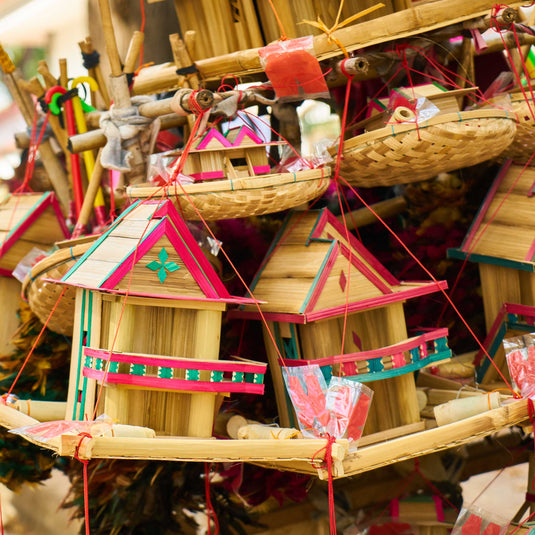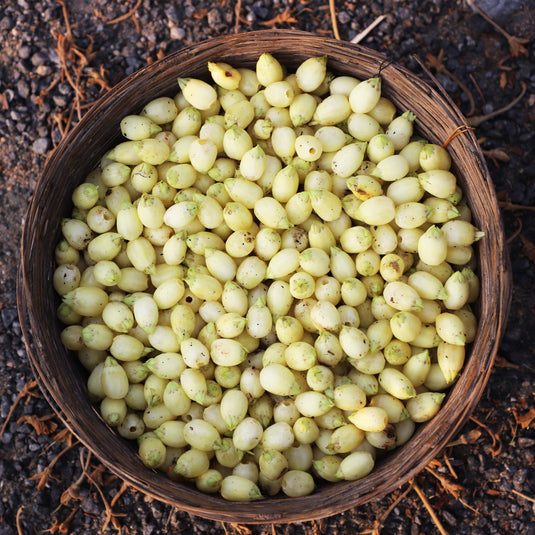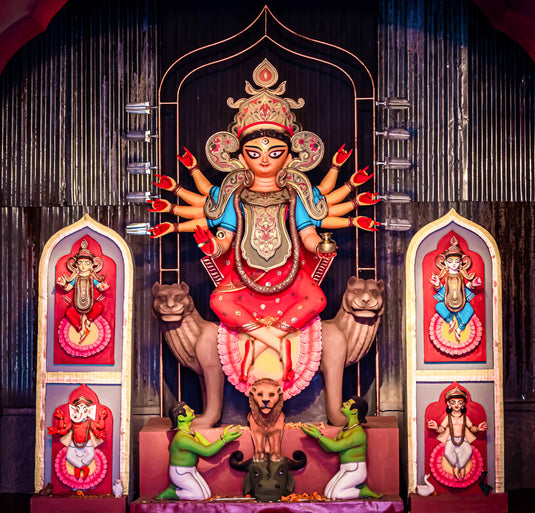From the land of Dakshin Rai and Bon Bibi

The world’s largest Mangrove Forest, Sundarbans, with enormous beauty shared between India and Bangladesh, is also known as land of Honey Hunter. Sundarbans, forested wetland, is full of secret and mysteries such as story of Dakshin Rai, Bon Bibi, Begho Bhoot. Sundarbans forest, the land of man-eating tigers, home of royal Bengal tigers, has several groups of islands, some of which are inhabited and some are thickly forested. Other than the striking poverty, attacks by tigers, crocodiles, venomous snakes and bees are a regular phenomenon. The forest is blessed with some of the most amazing plants such as Khalsi, Goran, Passur, Gewa and Sundri. Some people believes that Sundarbans name is derived from the Sundri tree which is found abundantly in the Sundarbans delta whereas some people believe that Sundarbans name is derived from the word "Samudraban" (Sea Forest). Sundarbans is also famous for the most lucrative of all the forest’s products and the most dangerous to gather i.e. Sundarbans forest Honey. It is home of wild giant honeybee, Apis Darsota and Apis Laborosia, which collects the nectar of these flowers and produces honey.
The Sundarbans forest starts to bloom in march and honey hunters starts harvesting the honey from April end onward. The honey bees construct their hive / combs sometimes several meters high in tree and sometimes few meters from ground. In a year, the honey bees produces honey from as many as eighteen to twenty species of flower and trees, each distinct in taste, aroma, texture, flavor and color.

Like a phantasmagoric, absurd and bizarre nightmare, the Sundarbans is equally beautiful and threatening. The wetland forest seems walled, the mud banks are a first line of defense, low-lying fortification that render invaders clumsy, slow, vulnerable. Phoenix palms, barbed with two-inch thorns, grow in dense clusters. The Gewa tree, a poisonous plant, releases toxic white sap secreted by the broken leaves, it may cause blindness if the sap touches your eyes. However, the sap also has medicinal properties and is used in the treatment of rheumatism. Peel back the gray bark of the Sundri tree and the young wood shines red, as though the tree itself were bleeding. Hundreds upon hundreds of stalagmite respiratory roots push up through the mud on the forest floor and creating a dreamy miniature. Instead of bugs, the ground crawls with crabs; instead of acorns, it’s studded with seashells. The ghostly backs of pale gray river dolphins occasionally break the deceptively still, mud-brown surface of the water, which conceals far less benign populations of crocodiles, river sharks, and venomous sea snakes. Hidden among the greenery there are cobras and kraits and pit vipers.
The honey hunters around the India use to come Sundarbans in March & April month to hunt the honey along with Mouwalis / Moule (local Honey Hunter) in a traditional fashion. The collection of honey is a team work and each team consist of 5-10 members. The honey hunters travel through muddy saltwater rivers, creeks and narrow channels that criss-cross the Sundarbans forests.

The role of Mouwalis / Moule is to arrange the boat, food supplies such as rice, cooking oil, pulses, spices, kerosene oil 30 – 45 days, basic medicine, pre-identify the hunting location etc. They also carry fish net to catch the fish for their daily meal.

The Mouwalis perform traditional prayer to their chief deity Dakshin Rai before entering the forest. Fear is a form of respect to Dakshin Rai who rules over beasts & demons and has been considered as lord of Sundarbans Honey & Wax. It is believed that he is living in Sundarbans forest in the form of Bengal Tiger. According to the Mouwalis (local honey collectors of Sundarbans), Dakshin Rai gives forest honey in exchange for a human life and he only afraid of "Ma Bonbiwi" (the lady of forest), the goddess mother.
In Sundarbans Mangrove Forest, You don’t protect the forest. If you’re lucky, the forest will protect you.
It is believed that Bon Bibi lives in the Sundarban forests and protects the peoples from the fearful Dakshin Rai, with whom she is eternally at war. It is fascinating that Bon Bibi figures in the religious rituals of both Muslims and Hindus. She appears in Durga Maa like clothing for her Hindu followers and as a female Monk (pirani) for her Muslim followers.

Once, there were two Mouwalis (Honey Hunter) brothers, Dhona and Mona in a village of Sundarbans. Dhona planned to go for a honey hunting with a fleet of seven boats to collect honey in some dense forest areas but his brother Mona opposed it. Dhona took a shepherd boy, Dukhe along with him. Before leaving, Dukhe's mother told him to remember Ban Bibi in case of any serious trouble. When the fleet reached the Kendokhali char, which was a part of the kingdom of Dakkhin Rai, Dhona forgot to give an offering to Dakshin Rai. As a result, he was not able to collect any honey or wax for three days. On the third night, Dakkhin Rai appeared Dhona's dreams and asked them for a human sacrifice. After some arguments with Dakkhin Rai, greedy Dhona agreed to sacrifice Dukhe in exchange for honey and wax. So, after collecting enough wax and honey, he left Dukhe there and returned to his village. When Dukhe was about to be killed by Dakkhin Rai in the disguise of a tiger, he started chanting prayers invoking Banbibi. On hearing his chant, Ban Bibi came along with her brother Shah Jangali. Shah Jangali defeated Dakkhin Rai. After his defeat, Dakkhin Rai took refuge with Bara Khan Ghazi. They followed Dakkhin Rai there. Finally, Bara Khan Ghazi was able to convince Ban Bibi not to harm Dakkhin Rai. In return, Ghazi gave Dukhe seven cartfuls of precious items, while Rai gave him a sufficient amount of wax and honey. Bon bibi ordered her pet crocodile, Seko, to drop him to his village. After his return to the village, Dukhe popularized the worship of Bon Bibi in the neighborhood.

It is customary to first revere Dakshin Rai before entering the forest, so that he doesn’t send any tigers your way. After performing the rituals and before entering the forest, Mouwalis and other honey hunter wear the mask with Dakshin Rai’s face on the back of their heads to prevent tiger attacks because tigers always attack from behind.

It is surprising but true that Royal Bengal Tigers (worshiped as Dakshin Roy of Sundarbans) feast on honey every chance they get. It is an easy game for tigers to feast on honey ones a comb is located by them. To prepare their body for honey hunting, tigers rolls himself in wetland and covers their body with thick mud layers of Mangrove forest. The mud forms a good shield round the tiger's skin when dries up in sometimes. Most of time it become so thick and strong that bee sting cannot penetrate it. Now tiger moves toward the pre-identified honey hive in the low rise tree. He runs long and jump high and with his strong paw hits the honey hive to the ground and runs away with full speed in the dense bushes to protect from stings of wild honey bees. After sometime, tiger returns to his trophy once honey bees disappears from hive and enjoy the forest honey.
The Dacoits (bandits) & pirates are plenty in Sundarbans in honey hunting season. Sundarbans Honey has huge cash value; dacoits use to steal honey from honey hunters or even kidnap them. They patrol the jungles in boats and hide in the creeks.

The entire honey hunters team lives in the boat and they have to face tigers on the ground and dacoits (bandits) in the river.

Honey hunters enters the forest when the sky is clear and the river is at low tide. One person stays behind to row the boat along the bank. The Mouwali after entering the forest and locating a giant honeybee colony, make torches from green hetal leaves along with some other materials for smoking to drive the bees from the comb. Sometimes the bees sense the threat and sting even before the smoke rises. Smoking removes most of the honeybees and Mouwalis collects the wax and honey from hive. We do not break the entire hive, since it needs to regrow.”
When some honey is gathered, it is deposited in the boat. Giant honeybee such as Apis Dorsata, Apis Laboriosa are the principal honey producing honey bees in the Sundarbans forest.

Khalsi flower from Khalsia / Khalshi tree is first most and best nectar and pollen producing plant. The honey produced from Khalsi flower are also known as Padma Madhu (Lotus Honey). The honey produced from Khalsi flower has a big demand and the honey is of very good quality with high moisture, good fragrance and taste and does not readily crystallize.
Unknown Honey Hunters of Katarniyaghat Forest
Sangri-la of Uttar Pradesh

With 230 km from Lucknow and at the border of Nepal, spread in around 400 sq km, the Katarniya Ghat Forest is a part of Dudhwa Tiger reserve. It also provides strategic connectivity between tiger habitats of Dudhwa and Kishanpur in India and Nepal. The Katarniya Ghat forest, home of million wild souls, an orchestra in itself, from the humble beetle to enchanting birds, wings fluttering, slithering & hissing, humming of insects & scary deep roar, playing one enchanting symphony after another.

The Motipur and Kakrha forest range are 2 main divisions of this wild life sanctuary. The wildlife is as varied as the forest itself, ranging from Gharial, Tiger and leopards to Rhino and a vast number of different birds, and it is now one of the best places in the world with complex of sal forests tall grasslands and riparian ecosystem of Girwa and Kaudiyala streams of Ghaghra river.

This forest region is very rich in honey bee diversity and there are good number of Apis Darsota, Apis Laboriosa and Giant honey bee nests are found in the forest. These honey bees are one of the important pollinator in the forest region. Most honeybees are diurnal and forage during the day, but the Dorsata are active during the dusk hours too.
"Any honey hive consists of one queen bee, thousands of worker bees (female bee) and drones (male bees). The role of drone bees is to mate with queen bee and drone bees die immediately after mating. The worker bees (female bees) are mainly forage for pollen and nectar, tend to queens and drones, feed larvae, ventilate the hive, defend the nest and perform other tasks to preserve the survival of the colony. The average life of worker bees are 2 -3 months whereas queen bee lives for 3 - 4 years. Apart of producing the honey in the nest, the another most important role of workers and drone bees are to protect the queen bee from any external threat and stress."
Honey hunting and collection of medicinal herbs and plants from the area of this forest region is a cash rich business for local Kamiha, Jamunetri, Yashodeva tribes of Kakrha and Motipur areas.

Jamunetri tribes of Uttar Pradesh are considered as matrilineal tribe. They do not prefer arranged marriages. Women are considered as head of family in Jamunetri tribe. There are lot of freedom given to women, youth are free to marry whoever they wish to without any form of parental pressure or aggression. They follow the Gotra system and do not marry within the same. The Jamunetri tribe practices polygamy where a woman is allowed to remarry and have multiple partners after her first marriage. The children's surnames are based on the mother's lineage and not the fathers. Also, it is the mother who inherits the property and not the father.

A trove of dark brown liquid, frozen in timeless forest - allows the continuation of the century-old practice of honey hunting The Jamunetri tribesmen are master honey hunters and the skills of the dangerous honey hunting are passed on from one generation to next one in their tribe. The tribes mostly collect the honey and natural wax by climbing the tall trees inside deep forest region. Tribe women prepares the necessary tools for men to climb and gather honey from the large trees. The tribesman treats the bees as scared being and they perform prayers to their chief deity, “Uttari Bhawani Mata” before leaving for honey harvesting.

Tribesman ventures for 15-20 days into the dense forests barefoot, a lungi (cotton cloth) tied around their waist and a 'Gamccha' (cotton towel) on the head. They take with them food supplies rice, utensils, bamboo, rope, ladder, axes and jars for honey hunting campaign which continues from April to June every year.

The bees are driven away with the help of a smoker and the smoke from smouldering grass disorients the bees and the honey part of the hive is cut off. They do not cause harm to the ecology and wild animals and are trained to collect honey in a sustainable way so that after a hive is harvested the honeybees return and rebuild the hive at the same place.
In recent times, with reduced forest cover, climate change and government restrictions, it has become increasingly difficult for these tribes to collect wild honey. The early rain drives off the wild honey bees which hugely impact the availability of honey in the forest.

Facing insurmountable dangers, such as the wild tiger or herd of elephants, honey hunters not only gathers the wild forest honey, but also collects stories along the way, his own and of those who join in the hunt, and returns to the village with both of these precious things – one to fill the stomach, and one to fill the soul.
Every year around 2000 kg – 2500 kg honey harvested by the honey hunters in this areas.
Honey Hunters of Odra-Desh
The Land of Lord Jaganaath

Kandhamal, one of the poorest district of Odisha (earlier it was known as Phulbani), is a tribal dominated district where majority of the people belong to the Kondh (Kandha) tribe. Around 71% land area is forest and 12% of the land is cultivable. The organic turmeric cultivated in this district is popularly known as 'Kandhamal Haladi' and is renowned for its purity.

The district is full of flora and fauna. A wide variety of wildflowers like orchids are found in the dense forests of the district. Mango, mahula (mahua), Indian gooseberry (amla), kendu, meswak and jackfruit are also found in abundance in the wilderness. Dependent on forests for their livelihood, they collect fuel wood, grass, medicinal plants, fodder, herbs and roots.

Their food, vegetables, roots and ferns such as jibura, linguda, parmal or fish and jungle birds, comes from these forests. Apart of Babmboo and broom grass, honey collection from dense forest region of Kandhamal is one of the quick cash earning job.
The tribes are trying to keep their tradition alive. The tribesman walk up 60 - 80 km for three days deep inside the forest and walk down for as many days to collect a specific type of bamboo stick essential to the annual rituals. To offer their goddess Duarseni, apart of 18 items offered, the tribal community also use to prepare delicious cake of Ganher trees.
Honey hunting is an old age practice among the tribes and harvesting honey from trees and cliffs are an important source of income for tribes. Man has been hunting and raiding the wild bees nests in forests at least since he evolved into his contemporary form.

Twice a year (Jan - March, Oct - Dec), wrapped in swarms of thousands of bees, the honey hunters work without any protection in deep forest region. They hunt barefoot and entrust their lives only to a strong rope and long purification rituals: for weeks before harvest time begins in the forest, perform daily prayers, avoid any contact with women and follow a strict vegetarian diet. Honey Hunters would go out deep into the forest for months at a time. The practice supplements kitchens, and during it the tribesman also collect medicinal plants and herbs. Children go hunting and foraging because it is a matter of survival, custom, and ritual. Hunting enables children to learn about nature and imbibe traditional knowledge that generations before them have cultivated. Living in harmony with Nature has been an integral part of this tribe and it abundantly reflected in a variety of traditional practices, religious beliefs, rituals, folklore, arts and crafts, and in their daily lives.

The honey of wild honey bees, Apis Dorsata, which is also known as "Liquid Gold" is found in good quantity in forests. There are more than 700 different species of rhododendron in the world but only very few are having grayanotoxin (natural compound) in their nectar. Rhododendron species of plants are found in forest and the honey produced by wild honey bees from the nectar of the the flower of Rhododendron species are having hallucination properties which is consumed in regions of Odisha as a recreational drug and traditional medicine.

Honey’s antioxidant and antibacterial properties help improve the digestive system and boost immunity.Honey’s antiseptic properties inhibit the growth of certain bacteria and help keep external wounds free from infection. It helps reduce swelling, pain and even scarring as it works as an anti-inflammatory as well.
For thousands of year, humans have trained animals to help them such as dogs sniff the drungs and mines, Pigs locate truffles, similarly, a honeyguide bird which locally known as "Tumba" use to work with honey hunters of tribes to locate the honey bee hives in the forest. Tumba bird love wax of honey bees whereas tribesman love honey “So there’s no conflict of interest over the reward. The tribesman call the honeygudie Tumba bird with loud sound of "Kooddd-hm" and Tubha leads them to the nests. Its a sound which honey hunters learn from their fathers and call is “a reliable signal to honeyguides that this is a human who’s looking for bees and is more likely to be a good collaborator. Tumbha Birds have figured out that people are the best partners in this endavor because they know how to use fire - and bee danger averted.

The final outcome from the honeycomb in the middle of the dense and silent forest comes as an unexplained smoked woody flavor honey which causes a sharp burning sensation in the throat. Not only human being but forest animal such as Tiger, Bear, Monkey and many more use to eagerly wait to rob wild honey hive and get a piece of it. Forest is also full with many more mysterious honey which could be in very different in color, taste and texture. One such secret honey is locally known as "Vandeva Saswad Madh".

In the month of November, the tribes also use to harvest very unique, mysterious and rare green wild honey (fluorescent color) from the hive of wild honey bees in Kandhamal forest. Local tribes use to eagerly search for green honey producing hive in the forest and wait for this honey throughout year. It is still not known the reason of this green color in honey, however, it is assumed that honey bees has produced it from various type of Giloy. Tribes believe that this green honey is a blessing of their deity Vandeva "Lord of Forest". After harvesting the honey from the honey hive, tribe first offer this honey along with rice (known as "Saswad") to their deity. It is then distributed and eaten by the tribes and they sell the extra honey to their nearby local market. Local people use to treat several diseases using this secret honey and also known to increase the fertility in the human being.
Cashless Economy - The Barter System of Tribes
Land of Tribal Honey Hunters

Spread in 4200 sq km, larger then the state of Goa, Abujmarh is a huge area of dense forest, mountains and several rivers, isolated from the outside world and largely inaccessible,and is also known as "liberated-zone" as it is an alleged hub of Naxalite-Maoist insurgency. It is part of chattisgarh state of India and it is home to indigenous tribes of India, including Muria, Abuj Maria, Gond and Halbaas. Govt. had restricted on the entry of common people in this region, however, couple of year back it has been lifted. It remained untouched by any govt. presence and civil administration since independence of India. Here, Moaoist runs own government known as Janta Sarkar and their courts known as Jan Adalat. Ministry of Environment and Forests, Government of India has proposed to designate Abujmarh as a biosphere reserve.

It covers 3 district of Chhattisgarh state and is close to the borders of neighboring Orissa, Andhra Pradesh and Maharashtra states. Abujhmah is possibly the only piece of land in the country where there is no revenue map as yet; villagers have no title deeds (patta) to the land they live in or cultivate.
58 year old, Jhotiakhim Khulma belongs to Abuj Maria tribe, living with his tribe deep inside the lush green virgin forest hilly region which is 150 km from Dantewada district. Abuj Maria's gods includes clan gods, an earth-mother, village deities, mountain gods, ancestor spirits and spirits associated with every hill, lake, tree, rock and river. Jhotiakhim is suffering from knee-joint pain since last 2-3 years and "Jebdeba" (local Hakeem / Vaidhya) have urged Jhotiakhim to take greater caution while treking the hill ranges.

He has been advised to exercise caution while carrying any type of load / weight, however, this warning could not stop Jhotiakhim from two day trek, negotiating a hilly terrain, wild animals and rivulets, down the hills of Kabdidola in Abujmarh to the plains of Dantewada to attend annual barter fair.

He along with his tribal group will be carrying head-loads of home grown paddy, forest honey, Jobra (tribal sweets), Chapada Chutney and handcraft items to exchange with other tribes and non-tribal peoples for salt, sugar, mustard oil, soaps and clothes, ornaments and other basic daily needs via barter trade method-- without any monetary transaction. Dressed in a fitted red check cotton lungi with a white gamchha and a strip of printed cloth wrapped around his waist, walked with his tribe group to reach what the locals call their bazaar.

His tribe is proud being part of centuries-old tradition in Abujmarh where people from the hills and plains get together once a year and buy and sell their commodities via barter method. Like Jhotiakhim, thousands of people from across Abujmarh have been part of this tradition of seamless cashless transaction for three days every year at Baisakhi Mela. This is perhaps the world’s oldest barter trading system which is till alive and even people from urban settlements flock to the fair to enjoy the essence of cashless trading.

Forest honey is sold in larger quantities like two or three hundred kg in this Mela every year. Tribes generally sell the honey when they need money to perform marriages. Last year almost 2500 kg of forest honey were exchanged / sold via barter method and it was collection of 12 different tribes from the diversified forest region of Abujmarh. Honey lovers around the India use to come in this yearly tribal market to taste and purchase almost 25+ varieties of forest honey, harvested from dense forest area spread in around 3000 sq km.

Based on Nectar of flower, the honey comes in multiple colors such Red, Dark Black, Golden Light, Brown etc from very low viscosity to very high viscosity. The most famous honey of this barter market is Hotia Madhu (Mahuwa flora honey) which is very bitter in taste. Tribesman generally collects the honey 2-3 times in a year from the forest honey bees hives built on trees and cliffs and store it in wooden barrel and large clay pot. They generally use to preserve it for 2-3 years before selling in the market. This preservation period gives the sweet fragmented unique flavor to the honey.

After 3 days, Jhotiakhim Khulma is going back with commitment that he will come back next year again and devoted a beautiful song of his tribes to this yearly Mela.
Joriya Jopra Kheuma Na Tummmmm
Joriya Jopra Kheuma Na Tummmmm
Khemu Khemu Dikalnaal Chlena Dikalnaal
Joriya Jopra Kheuma Na Tummmmm
Supnem Maghe Maghe Namush Hai Maanush
Konchim Konchim Jimkhe Na Chikahe
Jubnu Na Mangtu Ne Jopra Na Mangtu
Joriya Jopra Kheuma Na Tummmmm -2
Land of 700 Hills - Saranda Forest
Paradise of wild forest honey, herbs and spices

Jharkhandi's Sarand forest, Naxalite dominating hilly forest region, spread in around 900 sq km, falls under Singhbhum district. Here, Maoists are having multiple training camps inside the forest region and runs own government known as Janta Sarkar and their courts known as Jan Adalat. It is also asia's largest sal forest and one of the least disturbed forest in India.

It is home for flying lizard, wild elephants, enriched with more than 40 species of mammals, 162 species of birds, 9 species of amphibians, and 33 species of reptiles.
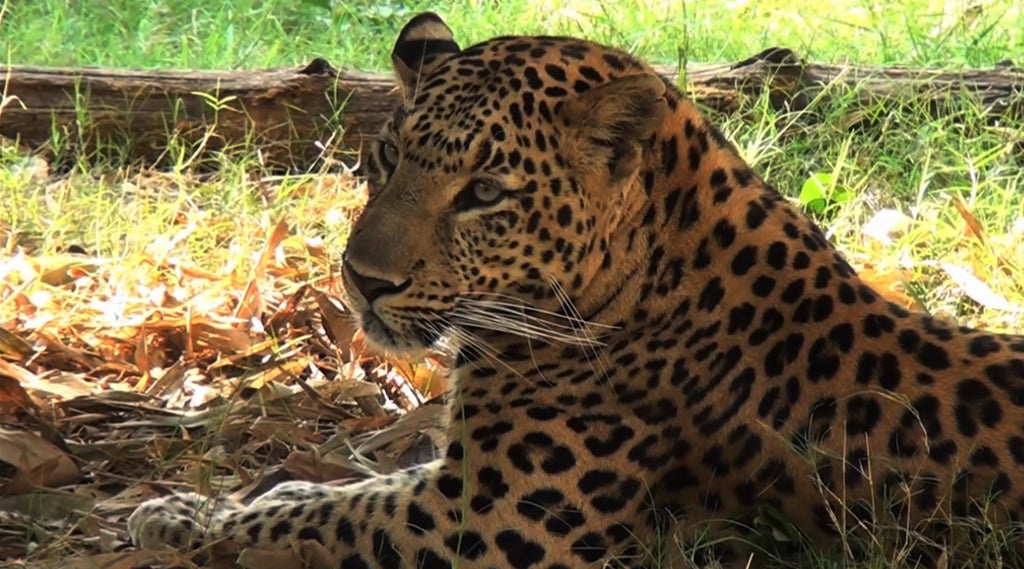
The forest is still inhabited by HO and nomadic Birhors tribes living in traditional ways and has declared the forest as an "prohibited" area for "outsiders".
For centuries, these tribes people have remained separate from the outside world thanks to the dense jungle surrounding their home in a deep gorge carved by the perennial rivers, Karo and Koina, pass through these forested areas supporting a diverse floral and faunal resource. The entire region remains isolated and remote, much of it is still a mystery.

Apart of Sal wood, the forest is blessed with 500+ types of medicinal plants and herbs and home of wild honey bees such as apis darsota and apis laborosia honey bees. Once in a year, in the month of June-July, most of the forest region blooms with a special kind of wild grass which locally named as "Kangira Koma".

The wild honey bees, apis darsota and apis laborosia honey bees, known for their aggressive attacking behaviour, collects the nectar from the flower of these wild grass and produces honey in the hive naturally built on trees and cliffs.
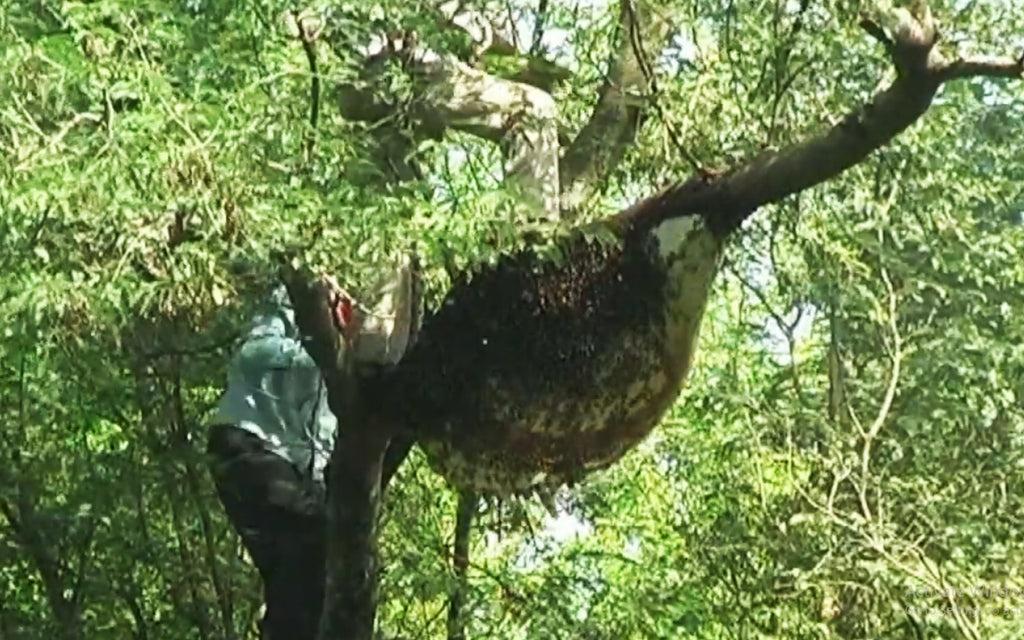
Each hive consists of 90,000 - 1,50,000 wild honey bees and each hive takes 15-20 day’s time to produces 7 - 10 kg honey. Nomadic Birhors tribes are skilled honey hunters, they use to carefully climb the 50 - 70 m high on the trees with Smoke from smouldering grass which disorients the bees, possibly reducing the number of stings climber will suffer.

The wild bees are guarding kgs of a sticky, reddish fluid which locally known "Madhma". This Jharkhandi raw honey is dark red in color with strong woody aroma and smoky taste.

The sweet buzzing jive of the bees in each warm sky has brought forth this honey, this golden sweetness with the taste of wildflowers. This honey is strong on taste and firm in consistency – much more so on both counts than regular honey. The subtle pine taste gives the honey a slight woody flavour. Locally people loved it, although it might not be to everyone’s taste.

From the rich brown earthen hues of the forest ground to the sweetness of the blue-white sky, the Saranda forest is a three dimensional wonderland for the eyes who are willing to absorb the light. It is a place of ancient souls, of the creatures who dwell with the sweet sounds of moving water and bird song. Somehow this is more home than home, it is a land where time stood still
.